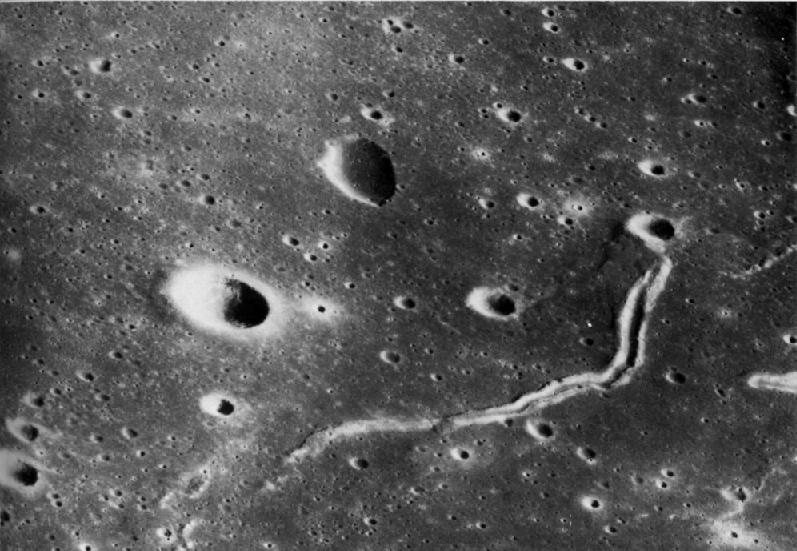
home •
about •
essential guide •
picture of the day •
thunderblogs •
news •
multimedia •
predictions •
products •
get involved •
contact
picture of the day archive subject index
Crater and rille in Mare Serenitatis. Credit: NASA/JPL/Apollo mission archive
Jul 28, 2008
Missing Matter-Missing DischargeThis third Picture of the Day in the series of contrasting visions compares two views of craters and rilles.
The image above shows a crater and a rille on the Moon. The presently accepted theory posits that the crater was caused long ago by the impact of an asteroid-size body. The rille is the remains of a lava tube whose roof collapsed, also long ago.
Astronomical bodies, whether asteroids or planets or even stars, are miniscule with respect to the volume of space in which they move. The chances of collision are remote. The probability of close approach is increased if the bodies move on similar orbits, but then their mutual gravity acts to prevent collisions, as we see for example with the "double planet" situation of Earth and Moon or Pluto and Charon. But if there were more bodies long ago, and if there were a long time interval, remote chances of collisions could have accumulated.
Craters that have been identified as impact structures on the Earth have failed to yield significant remains of the impactors. Perhaps the incoming bodies exploded or were vaporized. The amount of debris around the craters appears to be a fraction of the volume excavated. Perhaps the force of the impact explosion scattered most of the debris far from the crater. Also, the shape of the crater-flat floor, terraced walls, and steep central peak-is unlike craters produced in lab impacts and explosions. Perhaps the physics of asteroid-size impacts is different from that of lab experiments.
Collapsed lava tubes on Earth have rubble piled on their floors. But rilles have clean floors. They also have narrow sinuous grooves incised into the floors. Few rilles have outflows of material that would be expected if lava had once flowed through them.
But again, time heals all wounds, and with enough time, under conditions that no longer exist, impact scars and lava tubes might come to have an unexpected look.
The Electric Universe posits that the crater was caused long ago (but not that long ago!) by a planet-size electrical discharge. The shape of the crater corresponds to the shapes created by electrical discharges in labs, and the lack of debris corresponds to the electrical cleaning of spark-discharge machined surfaces.
The rille is the remains of a subsurface discharge that probably accompanied the crater-forming one. The discharge channel excavated the narrow sinuous groove in the floor, and the shock effects of the discharge blasted out the wider clean valley above it. The shape corresponds to the shape of scars left by lightning strikes to the surface of the Earth.
No one has seen an electrical discharge of a size to produce a lunar crater and rille, but spacecraft have discovered low-energy currents between bodies, for example the "flux tubes" connecting Jupiter and its moons or the "stringy things" in Venus's elongated sheath. Perhaps long ago (but not that long ago!) the planetary circuits experienced a surge that caused discharges.
The missing matter in impacts and debris is matched with the missing discharges. But in contrast to the mismatch between lunar craters and lab impacts, the effects of the missing discharges can be reproduced in miniature in labs.
__________________________________________________________________________
Please visit our new "Thunderblog" page
Through the initiative of managing editor Dave Smith, weve begun the launch of a new
page called Thunderblog. Timely presentations of fact and opinion, with emphasis on
new discoveries and the explanatory power of the Electric Universe."The Electric Sky and The Electric Universe available now!

|
|

|
EXECUTIVE EDITORS:
David Talbott, Wallace Thornhill
MANAGING EDITORS:
Steve Smith, Mel Acheson
CONTRIBUTING EDITORS: Michael Armstrong, Dwardu Cardona,
Ev Cochrane,
C.J. Ransom, Don Scott, Rens van der Sluijs, Ian Tresman
WEBMASTER: Brian Talbott
Copyright 2007: thunderbolts.info
![]()
home
thunderblogs
forum
picture of the day
resources
team
updates
contact us

